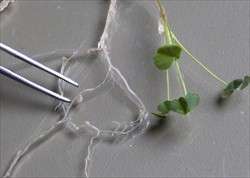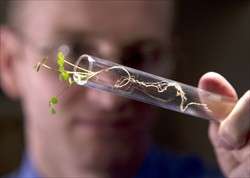Helping plants fertilize themselves

(PhysOrg.com) -- A BYU researcher helped discover a cellular tool some plants use to fertilize themselves. This fundamental understanding is important in the effort to reduce the 88 million tons of nitrogen fertilizer used worldwide every year. That in turn could help reduce fossil fuel use, because 3-5 percent of the world's natural gas is burned to make nitrogen fertilizer. The research is published in the journal Science.
Farmers buy 88 million tons of nitrogen fertilizer annually to grow staple crops such as corn, wheat and rice. And it takes 3 to 5 percent of the world’s natural gas to make all that fertilizer. That’s frustrating because three-fourths of the Earth’s atmosphere is nitrogen, but it’s in a form that most crops can’t use.
But a few plants, such as alfalfa, soybeans and peanuts, can fertilize themselves, in a way, thanks to a friendly bacterial infection. These legumes recruit bacteria that “inhale” naturally occurring nitrogen from the atmosphere and convert it into the useful form that plants use for food.
A Brigham Young University professor was part of a Stanford team that discovered an unexpected piece of cellular machinery these plants use to send molecules into the microbes to help them get established in their new home in the plants’ roots. The researchers report their results in this week’s edition of Science, the top American scientific journal.
These findings are fundamental to this important process, so the hope is that someday researchers can help the legumes and bacteria work even better together. A dream scenario would be to take an improved understanding of this process of “fixing” natural nitrogen and genetically program other crops - corn, wheat and rice - to welcome these bacteria into their roots, so they too, can fertilize themselves.
“Think how much energy consumption could be offset if we could rely more on biological nitrogen fixation, which is solar-powered,” said Joel Griffitts, BYU assistant professor of microbiology and co-author on the Science paper.
Griffitts worked on the project when he was a postdoctoral researcher in the lab of Stanford’s Sharon Long, who is also an author. Dong Wang, a postdoctoral scholar in Long’s lab, is the lead author.
Nitrogen is essential to life on earth. Humans need 11 grams per day, for example, compared to 20 milligrams of iron per day. Too bad all that nitrogen in the air and soil is in a form that is chemically useless to most living things.
That’s what makes this alliance between legumes and bacteria so special.
“Here’s a system in legumes that pulls nitrogen right out of thin air and converts it into fertilizer,” Griffitts said. “I can give you one plant with these bacteria and one without them, and if I don’t feed the second one nitrogen fertilizer, then the plants with the bacteria will be much larger and greener after just a few weeks.”

The relationship begins when a lucky bacterium of this type - called rhizobia - encounters the root of a legume in soil and gets invited inside. The plant creates a nodule on its root - a “high-density residence hall for bacteria,” Griffitts says. There the plant protects the microbes and sends them energy generated by photosynthesis in return for the bacteria-generated useful nitrogen.
“The plants nurture these bacteria - sort of like farming them - and they have to do it very carefully,” Griffitts said. “We’ve found a pathway by which the plants deliver the right molecules to the bacteria to facilitate nitrogen fixation.”
Although the research looks only at the fundamentals of this important process, possible future applications include:
• Fine-tuning the process in legumes so they are more efficient at producing useful nitrogen and therefore grow better.
• Someday transferring this nitrogen fixation process to important crops outside the legume family.
• Learning more about how diseases progress, because many of the genes involved in the relationship between the bacteria and plants are also required for the development of bacterial disease.
“This type of study brings us that much closer to understanding all of the steps that are required to get this special arrangement right,” Griffitts said.
Provided by Brigham Young University
















